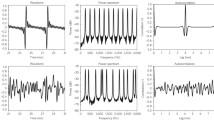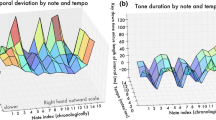Abstract
Based on a newly developed method that combines finger position tracking and spectral analysis of the concurrent acoustic record, we studied the accuracy and variability of pitch performance in eight skilled cellists and the role of acoustic feedback in their performance. The tasks required shifting movements between pairs of notes and separated by various distances (pitch intervals) on a single string at the rate of 1 note/s. The same tasks were performed either using the bow, providing acoustic feedback, or without the bow. Overall, our subjects exhibited a high degree of accuracy in executing tasks when using the bow. When using the bow, two types of variability were observed: (1) trial-to-trial variability: in most subjects the mean fundamental frequency of a single nominal note was significantly different from trial to trial; and (2) within-trial variability. The within-trial variability includes two sub-types: (a) the pitch of a given note changed between notes within a 50-note trial; and (b) within a single note there were positional changes that we hypothesize are attempts by the performer to adjust the fundamental pitch within the note. When acoustic feedback was absent, note distributions were shifted, multimodal, and had large variability; error-correction movements within a single note also significantly decreased, indicating that the stability and precision of the motor map depends on constant re-calibration and updating by acoustic information. Our results suggest that a performer’s intonation should not be viewed as a fixed entity implied by the score but as a sample from a statistical distribution.






Similar content being viewed by others
References
Baader AP, Kazennikov O, Wiesendanger M (2005) Coordination of bowing and fingering in violin playing. Cogn Brain Res 23:436–443
Bamberger J (1991) The mind behind the musical ear. Harvard University Press, Cambridge
Brown LE, Rosenbaum DA, Sainburg RL (2003) Limb position drift: implications for control of posture and movement. J Neurophysiol 90:3105–3118
Chen J, Woollacott M, Pologe S (2006) Accuracy and underlying mechanisms of shifting movements in cellists. Exp Brain Res 174:467–476
Drake C, Palmer C (2000) Skill acquisition in music performance: relations between planning and temporal control. Cognition 74:1–32
Finney SA, Palmer C (2003) Auditory feedback and memory for music performance: sound evidence for an encoding effect. Mem Cognit 31(1):51–64
Fyk J (1995) Melodic intonation, psychoacoustics, and the violin. Organon, Zielona Gora
Gabrielsson A (2003) Music performance research at the millennium. Psychol Music 31(1):221–272
Gates A, Bradshaw JL (1974) Effects of auditory feedback on a musical performance task. Percept Psychophys 16(1):105–109
Ginzburg LS (1983) Western violoncello art of the 19th and 20th centuries, excluding Russian and Soviet schools. Paganiniana, Neptune City
Larson CR, Hain TC (2007) Effects of simultaneous perturbations of voice pitch and loudness feedback on voice F0 and amplitude control. J Acoust Soc Am 121(5):2862–2872
Moore GP, Hary D, Naill R (1988) Trills: some initial observations. Psychomusicology 7:153–162
Morrison S (2000) Effect of melodic context, tuning behaviors, and experience on the intonation accuracy of wind players. J Res Music Educ 48:39–51
Palmer C (1997) Music performance. Ann Rev Psychol 48:115–138
Palmer C, Meyer R (2000) Conceptual and motor learning in music performance. Psychol Sci 11:63–68
Pierce JR (1983) The science of musical sound. Scientific American Library, New York
Repp BH (1999) Effects of auditory feedback deprivation on expressive piano performance. Music Percept 16(4):409–438
Winold H, Thelen E, Ulrich BD (1994) Coordination and control in the bow arm movements of highly skilled cellists. Ecol Psychol 6(1):1–31
Zatorre RJ, Chen JL, Penhune VB (2007) When the brain plays music: auditory-motor interactions in music perception and production. Nat Rev Neurosci 8:547–558
Acknowledgments
We thank Gary Felsing (Motus Bioengineering, CA, USA) and Dmitry Rozhetskin for support and assistance in the experimental trials. The authors also wish to thank Bruno Repp and another anonymous reviewer for their helpful comments on the earlier version of this manuscript. This research was partially supported by a grant from the GRAMMY Foundation. http://www.grammyfoundation.com/grants
Author information
Authors and Affiliations
Corresponding author
Rights and permissions
About this article
Cite this article
Chen, J., Woollacott, M.H., Pologe, S. et al. Pitch and space maps of skilled cellists: accuracy, variability, and error correction. Exp Brain Res 188, 493–503 (2008). https://doi.org/10.1007/s00221-008-1380-2
Received:
Accepted:
Published:
Issue Date:
DOI: https://doi.org/10.1007/s00221-008-1380-2




